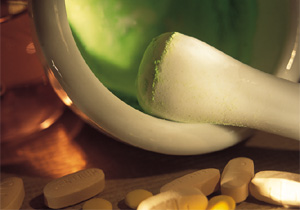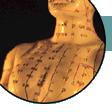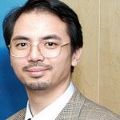Diagnosis Methods in TCM
The human body is an organic entity, so local pathological changes
may affect the whole body. Moreover, the pathological changes of
the internal organs may reflect on the body surface.
Diagnostic methods in traditional Chinese medicine include four
basic methods: inspection, auscultation and olfaction, inquiry and
palpation. The case history, symptoms, and signs gained through
those four diagnostic methods are analyzed and generalized to find
the causes, nature, and interrelations of the disease, and to provide
evidence for the further differentiation of syndromes. The four
diagnostic methods are therefore indispensable and important steps
in the differentiation and treatment of syndromes.
More about Inspection and
Auscultation and Olfaction.
Therapeutic Principles
Therapeutic principles are the basis for guiding clinical practice.
They include biao (branch or surface symptoms) and ben (root or root cause), that is, the principle of
treating a disease by analyzing both its root cause and symptoms.
Thus, factors such as climatic and seasonal conditions, geographic
localities, and the patient's personal conditions must be considered in
treatment, along with strengthening the zheng qi (the patient's body
resistance or anti-pathogenic factors) and dispelling the xie qi
(pathogenic factors).
1. The Principle of Biao and Ben
Biao and ben are contrasting concepts used to indicate the primary
and secondary relationships of contradictory sides in various kinds
of diseases and syndromes. For example, body resistance (or
anti-pathogenic factors) are considered ben (root) while pathogenic
factors are biao (branch); etiology is ben, symptoms is biao; primary
disease in ben, secondary disease is biao; pathological changes of
internal organs are ben, body surface is biao, etc.
The principle of biao and ben is used in traditional Chinese
medicine to treat the symptoms at the acute stage and to treat the
root of disease at the chronic stage. If biao and ben have the same
severity, treatment should then be applies to both ben (root cause)
and biao (symptoms).
2. Strengthening the Zheng Qi and Dispelling Xie Qi
Zheng qi is the ability of body resistance against disease. Xie qi
are the pathogenic factors. Strengthening the zheng qi and dispelling
xie qi are two differing therapeutic principles. Generally,
strengthening the zheng qi is used where body resistance is weak
and pathogenic factors are not strong; dispelling xie qi is applied
to cases which have excessive pathogenic factors, and also an
unweakened body resistance. First, strengthening zheng qi and then
dispelling xie qi is used in cases where the zheng qi and xie qi are
not weakened. The simultaneous strengthening of zheng qi and
dispelling of xie qi is applied in cases of weak body resistance
where pathogenic factors are in excess. When this principle is employed,
one must differentiate between what is primary and what is secondary.
In strengthening zheng qi, allow for unforeseen pathogenic factors, and
when dispelling pathogenic factors, do not influence the body resistance.
It is necessary to make the principles of "strengthening body resistance"
and "dispelling pathogenic factors" complement each other.
3. Principle of Treatment Based on Climatic and Seasonal Conditions, Geographic Localities, and Patient's Personal Conditions
Disease is the outcome of the struggle between body resistance and
pathogenic factors. Therefore, in the treatment of a disease certain
factors and conditions should be considered, that is, time (seasonal
and climatic conditions), place (geographical location and environment),
and personal characteristics (living customs, age, sex, and body
constitution). In the clinical application of medicinal herbs these
factors are also very important. This is an important therapeutic
principle guiding clinical practice in traditional Chinese medicine.
Examples follow:
In summer, the surface pores on the body are open or loose, while
in winter they are closed and tight. If the body is affected by the
same exogenous pathogenic wind and cold both in summer and winter then
pungent drugs having a warming property of relieving exterior syndromes
should not be administrated in summer, but should be used in large dosage
in winter. Because summer is humid, the pathogenic factors which cause
diseases in this season always mix with damp. Therefore, medicinal
herbs used for summer diseases should be combines with herbs having
properties of dissolving or removing damp.
The weather in mountainous regions and on plateaus is dry and cold,
medicinal herbs having cold, cool, bitter, or dry properties should not
be prescribed in large doses. White the climate in low-lying country
is warm and humid, so drugs having cool and damp dissolving properties
can also be used in large dosages.
Children have a body constitution of young and tender yang, for
which qi and blood are not yet abundant, and a flourishing vitality.
The vitality of aged people, however, is declining and qi and blood
are insufficient. Therefore both children and elderly patients should
not be prescribed drugs having strong properties, nor be given large
dosages.
Obese patients are liable to have diseases caused by internal
pathogenic damp, so drugs with cool, moist properties must not be
given. Most this patients are suffering from illness due to pathogenic
fire, thus medicinal herbs with warm dry properties are not suitable.
The same disease, but with different sexes, different physiological
characteristics, and different body constitutions should be treated
accordingly.
Chinese medical theory, as a product of traditional Chinese culture,
reflects an extraordinary sensitivity toward Nature. Throughout the
world, traditional Chinese medicine is praised for its holistic attitude
in the understanding and curing of disease. With a 2,000-year written
tradition, Chinese medical culture has accumulated an impressive body
of theoretical and practical experience.
|

 This website is published, edited and designed by Raymond Cheng,
and reflects only and only his personal views and opinions in his individual capacity.
The information available at this website is not intended
directly or by implication to either diagnose or treat any
medical, emotional, or psychological condition or disorder.
It is also not intended to create a physician-patient relationship
between you and I or between you and Wyith Institute™ and The Office of Dr Raymond K K Cheng.
The information here is not a substitute for advice and treatment provided
by your physician or by another healthcare professional.
It is always recommended that consultation with local healthcare providers
be obtained for any of your specific health or medical concerns.
Furthermore, any products that can be purchased (yet you can see I don't have much
to sell here) through advertisers' banners or through links to other websites
are not either explicitly or implicitly given any warranty or endorsement
by me, my colleagues, Wyith Institute™ or any of its associated businesses.
This website is published, edited and designed by Raymond Cheng,
and reflects only and only his personal views and opinions in his individual capacity.
The information available at this website is not intended
directly or by implication to either diagnose or treat any
medical, emotional, or psychological condition or disorder.
It is also not intended to create a physician-patient relationship
between you and I or between you and Wyith Institute™ and The Office of Dr Raymond K K Cheng.
The information here is not a substitute for advice and treatment provided
by your physician or by another healthcare professional.
It is always recommended that consultation with local healthcare providers
be obtained for any of your specific health or medical concerns.
Furthermore, any products that can be purchased (yet you can see I don't have much
to sell here) through advertisers' banners or through links to other websites
are not either explicitly or implicitly given any warranty or endorsement
by me, my colleagues, Wyith Institute™ or any of its associated businesses.



 Thank you for visiting this TCM and acupuncture information website.
If you have previously been to this website, you might have
noticed that some of the pages on ancient historical ideas and
holistic thinkings related to Chinese metaphysics are temporarily taken offline.
This is because I will be revamping the whole website and be moving
those information into a new \"Ancient Chinese Culture\" section
so as to reflect a more current perspective on the interpretation
of some of the fundamental concepts as well as to include
some of the latest information in the area.
But if you have just found this website for the very first time, I welcome you again and
wish you could find what you require and, hopefully, you could also be benefitted
from reading the articles I published on this website.
Thank you for visiting this TCM and acupuncture information website.
If you have previously been to this website, you might have
noticed that some of the pages on ancient historical ideas and
holistic thinkings related to Chinese metaphysics are temporarily taken offline.
This is because I will be revamping the whole website and be moving
those information into a new \"Ancient Chinese Culture\" section
so as to reflect a more current perspective on the interpretation
of some of the fundamental concepts as well as to include
some of the latest information in the area.
But if you have just found this website for the very first time, I welcome you again and
wish you could find what you require and, hopefully, you could also be benefitted
from reading the articles I published on this website.